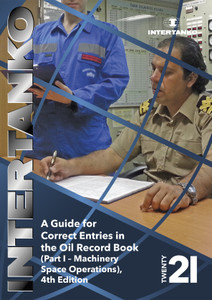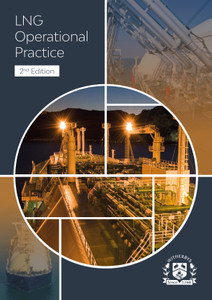
This publication provides guidance on proper and consistent completion of the Oil Record Book (Part II – Cargo/Ballast Operations) for oil tankers, as stipulated by Regulation 36 and Appendix III of Annex I of MARPOL 73/78. It sets out instructions and general requirements for making entries in the ORB Part II and lists the items that must be recorded. It also contains example entries for commonly used cargo/ballast operations.
This guide complements the INTERTANKO publication A Guide for Correct Entries in the Oil Record Book (Part I – Machinery space operations).
It provides simple and clear advice and guidance for making entries in the ORB Part II with the aim of:
- Ensuring compliance with the relevant MARPOL Annex I requirements
- Facilitating and simplifying the onboard work of the responsible officers and the Master
- Ensuring uniform and consistent ORB Part II recordkeeping that is aligned with and compatible with other shipboard logbooks and records.
It is structured in a user-friendly manner and can also be used both as an onboard guide and as a training tool for seafarers and shore-based personnel, including ship operators, surveyors and inspectors. It has also been designed to facilitate integration in the document management system of any individual Member of INTERTANKO.
1. Prologue
The INTERTANKO Safety and Technical Committee (ISTEC) has developed this Guide to assist ship operators in providing guidance to their seagoing personnel for the proper and consistent completion of the Oil Record Book (Part II – Cargo/ballast operations) (hereinafter referred to as ORB Part II), as stipulated by Regulation 36 and Appendix III of Annex I of MARPOL 73/78, as amended, thus minimising the risk for possible errors in logging information and record-keeping in the ORB Part II.
The Guide has been written to complement the INTERTANKO publication A Guide for Correct Entries in the Oil Record Book (Part I – Machinery space operations). It is structured in a user-friendly manner and it can also be used as a training or guidance tool for seafarers and shore-based personnel, including ship operators, surveyors and inspectors.
INTERTANKO would like to thank the members of the INTERTANKO Safety and Technical Committee for their support and to extend special thanks to Mr. Takis Koutris of Roxana Shipping for support in the review process.
INTERTANKO also wishes to thank all those who, over time, have provided invaluable feedback.
2. Introduction
2.1 Scope of the Guide
The Guide is applicable to oil tankers and refers to the entries that have to be made in the Oil Record Book Part II – Cargo/ballast operations (ORB Part II), in accordance with the requirements for oil tankers of regulation 36 and Appendix III: Form of Oil Record Book of MARPOL Annex I.
2.2 Objective of the Guide
The objective of this Guide is to provide simple and clear advice and guidance for making entries in the ORB Part II with the aim of:
- Ensuring compliance with the relevant MARPOL Annex I requirements;
- Facilitating and simplifying the onboard work of the responsible officers and the Master; and;
- Ensuring uniform and consistent ORB Part II record-keeping that is aligned with and compatible with, other shipboard log books and records.
In all cases and for all examples, opinions and guidance, Members are strongly recommended to get their Flag Administration approval, who ultimately have the final say.
2.3 Content of the Guide
The Guide consists of the following:
- General requirements and instructions for making entries in the ORB Part II, as set out in Section 3;
- List of items to be recorded in the ORB Part II, as set out in Section 4; and
- Detailed model examples of the ORB Part II entries for commonly used cargo/ballast operations, as set out in Section 5.
- Frequently Asked Questions (FAQ) and answers on items that either bring further clarification to examples provided in the Guide, or bring clarification on a few situations where INTERTANKO could provide an opinion but refrains from providing a guidance.
2.4 Additional items included in the second edition of the Guide
- New examples: 4b, 10a, 10b, 16, 18b and 20.
- Further clarifications to the notes for examples 1, 9, 11 and 18a; and
- New Section 6 with Frequently Asked Questions (FAQ).
INTERTANKO’s observations and clarifications are recorded in italics throughout the Guide.
The Guide is structured to facilitate integration in the document management system of any individual Member of INTERTANKO.
1. Prologue
2. Introduction
2.1 Scope of the Guide
2.2 Objective of the Guide
2.3 Content of the guide
2.4 Additional items included in the second edition of the Guide
3. General Requirements and Instructions
4. Items to be Recorded
A. Loading of oil cargo
B. Internal transfer of oil cargo during voyage
C. Unloading of oil cargo
D. Crude oil washing (COW tankers only)
E. Ballasting of cargo tanks
F. Ballasting of dedicated clean ballast tanks (CBT tankers only)
G. Cleaning of cargo tanks
H. Discharge of dirty ballast
I. Discharge of water from slop tanks into the sea
J. Collection, transfer and disposal of residues and oily mixtures not otherwise dealt with
K. Discharge of clean ballast contained in cargo tank(s)
L. Discharge of ballast from dedicated clean ballast tanks (CBT tankers only)
M. Condition of oil discharge monitoring and control system
N. Accidental or other exceptional discharges of oil
Additional operational procedures and general remarks – Tankers engaged in specific trades
O. Loading of ballast water
P. Re-allocation of ballast water within the ship
Q. Ballast water discharge to reception facility
5. Examples for Cargo/Ballast Operations
Example 1: Loading of oil cargo – one loading port
Example 2: Loading of oil cargo – multiple loading ports
Example 3: Unloading of oil cargo – one discharge port
Example 4a, 4b: Unloading of oil cargo – multiple discharge ports
Example 5: Internal transfer of oil cargo during voyage
Example 6: Crude oil washing
Example 7: Ballasting of cargo tanks
Example 8: Discharge of dirty ballast into the sea
Example 9: Cleaning of cargo tanks (transfer of tank washings to slop tanks)
Example 10a: Cleaning of cargo tanks (continuous water wash prior to dry-docking)
Example 10b: Cleaning of cargo tanks (sequential water wash prior to dry-docking)
Example 11: Discharge of water from slop tank(s) into the sea
Example 12: Discharge of clean ballast contained in cargo tank(s)
Example 13: Disposal of slops to port reception facilities
Example 14: Transfer (disposal) of sludge from engine room oil residue (sludge) tank(s) to slop tank(s)
Example 15: Transfer (disposal) of bilge water from engine room oily bilge water holding tank(s) to slop tank(s)
Example 16: Transfer from slop tank to slop tank
Example 17a: ODME failure
Example 17b: Rectification of ODME failure
Example 18a: Missed operational entry
Example 18b: Incorrect entries
Example 19: Pre-discharge pressure/leakage test of the COW piping system
Example 20: Entry cannot be entirely written in one page
6. Questions, Answers and Clarifications
INTERTANKO (the International Association of Independent Tanker Owners) is a trade association that has served as the voice for independent tanker owners since 1970, representing the interests of its Members at national, regional and international levels.
The organisation champions an industry dedicated to support global energy networks by delivering safe, efficient and environmentally sound transport services.
INTERTANKO actively works on a wide range of operational, technical, legal and commercial issues affecting tanker owners and operators around the world. It draws on regular and direct contact with its Members and other industry stakeholders to develop and disseminate information and best practice, essential to the tanker industry.
- Number of Pages:
- 26
- Published Date:
- February 2021
- Binding Format:
- Paperback
- Book Height:
- 296 mm
- Book Width:
- 210 mm
- Weight:
- 0.5 kg
- Author:
INTERTANKO
- Preview:
- Yes
- Publication Date:
- February 2021






